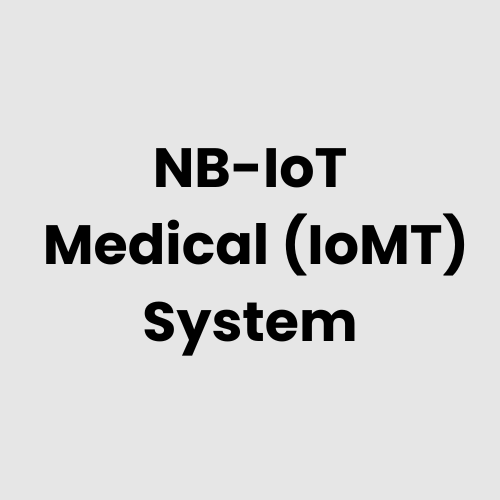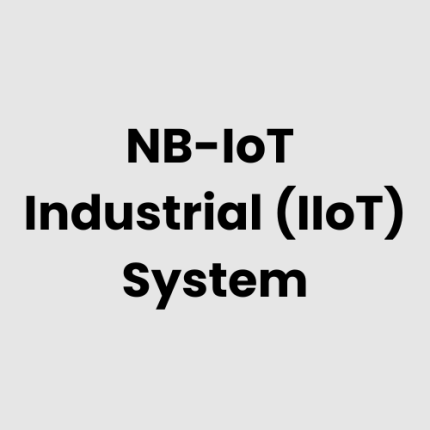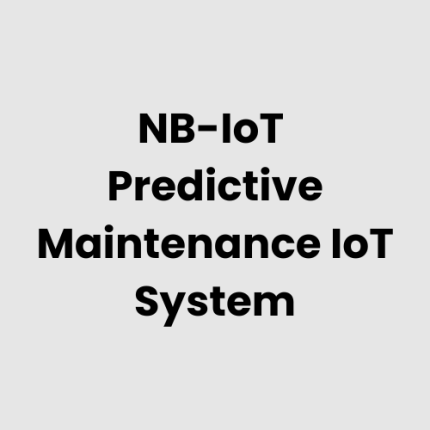Description
Technical Architecture
The NB-IoT Enabled Medical IoT (IoMT) System from GAO Tek Inc. empowers healthcare facilities with a secure, efficient, and reliable infrastructure for real-time patient monitoring, asset tracking, and operational optimization. Its architecture ensures seamless connectivity and advanced analytics for informed decision-making.
- Device Layer:
Includes wearable medical devices, environmental sensors, and diagnostic tools equipped with NB-IoT modules. - Connectivity Layer:
A robust NB-IoT network ensures stable and long-range communication, even in challenging environments such as basements or dense urban hospitals. - Edge Processing Layer:
Edge devices process data locally for latency-sensitive applications, such as critical patient monitoring and alerts. - Data Aggregation Layer:
Gateways collect data from connected devices, enabling centralized control and analysis. - Management and Insights Layer:
Centralized dashboards provide healthcare professionals with actionable insights, facilitating proactive patient care and efficient hospital management.
List of Hardware of the NB-IoT Enabled Medical IoT (IoMT) System
- Wearable Health Monitors: Track vital signs such as heart rate, blood pressure, and oxygen levels.
- NB-IoT Modules: Ensure reliable communication for all connected devices.
- Smart Bed Sensors: Monitor patient movement, weight distribution, and occupancy.
- Environmental Sensors: Measure temperature, humidity, and air quality in patient rooms and operating theaters.
- Infusion Pumps and Smart Medical Devices: Provide real-time usage data and enable remote control.
- Asset Tracking Tags: Track critical medical equipment such as ventilators, wheelchairs, and diagnostic tools.
- Gateways: Relay data from devices to local or cloud servers.
- Edge Computing Units: Handle local data processing for real-time applications.
- Smart Displays and Dashboards: Provide healthcare professionals with insights into patient data and operational efficiency.
Physical Placement Considerations
- Patient Monitoring Devices: Placed near or on patients for accurate real-time data collection.
- Environmental Sensors: Positioned in patient rooms, operating theaters, and storage areas for consistent monitoring.
- Gateways: Strategically located to provide maximum coverage and reduce signal interference.
- Asset Tags: Attached securely to medical equipment for accurate tracking.
- Edge Devices: Installed in proximity to critical monitoring areas to ensure low-latency processing.
- Displays: Positioned in nurse stations, control rooms, and critical care units for easy access to insights.
Hardware Architecture
The hardware architecture integrates multiple components for efficient healthcare management:
- Connected Devices (Wearables, Sensors, Smart Devices): Continuously monitor patient and environmental parameters.
- NB-IoT Modules: Embedded for efficient communication across the healthcare facility.
- Gateways: Serve as a bridge between end devices and central data systems.
- Edge Processing Units: Ensure real-time local data analysis and alert generation.
- Central Servers or Cloud Systems: Store, process, and analyze data for long-term trends and insights.
- User Interfaces (Dashboards, Apps): Provide healthcare staff with actionable information for decision-making.
Deployment Considerations
- Signal Strength: Optimize placement of NB-IoT gateways to ensure uninterrupted connectivity throughout the facility.
- Power Management: Use energy-efficient devices and backup systems to maintain operation during power outages.
- Data Security: Implement stringent encryption and authentication measures to safeguard sensitive patient data.
- Regulatory Compliance: Ensure the system adheres to healthcare standards and local regulations.
- Scalability: Design for easy integration of additional devices and services as the facility’s needs grow.
- Integration with Legacy Systems: Ensure compatibility with existing hospital systems for seamless operations.
List of Relevant Industry Standards and Regulations
- HIPAA – Health Insurance Portability and Accountability Act
- ISO/IEC 27001 – Information security management systems
- ISO 13485 – Quality management systems for medical devices
- GDPR – General Data Protection Regulation (for patient data security)
- FDA 21 CFR Part 11 – Electronic records and electronic signatures
- IEC 60601 – Medical electrical equipment standards
- ETSI TS 137 340 – NB-IoT specifications
- OSHA Standards – Healthcare facility safety regulations
Local Server Version
A local server version of the NB-IoT Enabled Medical IoT (IoMT) System ensures high data security and reliability:
- Real-Time Processing: Enables low-latency analysis of critical patient data and rapid alert generation.
- Data Ownership: Keeps sensitive patient data within the hospital premises, enhancing privacy and compliance.
- Operational Continuity: Functions independently of external networks, ensuring uninterrupted service during internet outages.
- Custom Configuration: Tailors data processing and system functions to meet the specific needs of the healthcare facility.
Cloud Integration and Data Management
Cloud integration enhances the scalability and analytical capabilities of the NB-IoT Enabled Medical IoT (IoMT) System:
- Centralized Monitoring: Facilitates oversight of multiple healthcare facilities from a single platform.
- AI-Driven Insights: Provides predictive analytics for early diagnosis, resource optimization, and operational improvements.
- Real-Time Data Access: Enables healthcare professionals to access patient data remotely, improving care delivery.
- Scalable Storage: Handles large volumes of patient and operational data securely.
- Seamless Integration: Connects with electronic medical records (EMR) and hospital information systems (HIS) for unified operations.
- Advanced Security Measures: Implements end-to-end encryption, role-based access control, and compliance with healthcare data regulations.
GAO Case Studies of NB-IoT Enabled Medical IoT (IoMT) Systems
USA Case Studies
- Boston, Massachusetts
In a leading hospital in Boston, NB-IoT technology is used to monitor patient vitals remotely. These systems enable continuous real-time tracking of heart rate and oxygen levels, allowing medical teams to respond swiftly to emergencies. GAO Tek’s expertise supports the integration of IoT devices in critical care environments. Explore IoMT applications in healthcare. - San Francisco, California
A medical facility in San Francisco employs NB-IoT sensors to track medical equipment usage and availability, improving operational efficiency. This system reduces delays in locating devices during emergencies. Learn about IoT in asset tracking. - New York City, New York
In New York City, a healthcare network uses NB-IoT to manage medication dispensers in real-time. This ensures timely refills for patients, reducing human errors and improving compliance. GAO Tek offers advanced IoT solutions for medication management. Discover IoMT for patient safety. - Dallas, Texas
A Dallas hospital integrates NB-IoT systems for neonatal monitoring. These devices provide real-time updates on infant health metrics, ensuring timely interventions and enhancing care quality. Read about IoT in neonatal care. - Seattle, Washington
In Seattle, an NB-IoT-based system optimizes hospital energy usage by monitoring HVAC and lighting systems. This reduces operational costs while maintaining a patient-friendly environment. Explore IoT for energy efficiency. - Chicago, Illinois
A Chicago medical center employs NB-IoT to track the sterilization status of surgical tools. This ensures compliance with strict hygiene standards and enhances patient safety. Learn more about IoT in surgical environments. - Miami, Florida
In Miami, NB-IoT-enabled devices are used to monitor elderly patients in assisted living facilities. These systems detect falls and abnormal activities, alerting caregivers immediately. GAO Tek supports such life-saving technologies. Discover IoT in eldercare. - Los Angeles, California
A Los Angeles hospital leverages NB-IoT to monitor environmental conditions in critical care units, including temperature and humidity, ensuring optimal patient care. Learn about IoT in environmental monitoring. - Phoenix, Arizona
In Phoenix, NB-IoT technology is integrated into mobile health platforms for diabetes management, allowing real-time glucose monitoring and reporting to healthcare providers. Explore IoT in diabetes care. - Atlanta, Georgia
A medical institution in Atlanta uses NB-IoT sensors to manage inventory for vaccines and medications. Temperature-sensitive storage is monitored to maintain efficacy and compliance. Discover IoT in pharmaceutical logistics. - Denver, Colorado
In Denver, NB-IoT enables remote monitoring of chronic respiratory patients through connected devices, reducing hospital visits while maintaining high-quality care. Learn about IoT in respiratory health. - Houston, Texas
A Houston hospital employs NB-IoT systems for smart bed management, optimizing patient flow and reducing wait times in emergency departments. Explore IoT in patient flow optimization. - Philadelphia, Pennsylvania
An NB-IoT solution in Philadelphia tracks hospital waste disposal, ensuring compliance with environmental and medical safety regulations. GAO Tek’s technologies simplify waste management for healthcare providers. Learn about medical waste management. - Orlando, Florida
In Orlando, NB-IoT devices enable real-time monitoring of infusion pumps, enhancing precision and reducing risks associated with manual adjustments. Read about IoT in infusion therapy. - San Diego, California
A San Diego clinic uses NB-IoT wearables for post-surgical monitoring, allowing patients to recover at home while staying connected to their care team. GAO Tek’s innovative IoT solutions empower remote healthcare. Explore IoT in telemedicine.
Canada Case Studies
- Toronto, Ontario
In Toronto, a healthcare institution employs NB-IoT sensors to monitor real-time air quality in operating rooms, ensuring optimal conditions for surgeries. GAO Tek’s solutions enable precise environmental control in critical settings. Discover IoT in surgical environments. - Vancouver, British Columbia
A Vancouver hospital integrates NB-IoT for smart wheelchair tracking, ensuring quick accessibility and reducing patient transfer delays. This enhances mobility and care efficiency. Learn about IoT in mobility solutions.
Navigation Menu for NB-IoT
Navigation Menu for IoT
- LORAWAN
- Wi-Fi HaLow
- Z-WAVE
- BLE & RFID
- NB-IOT
- CELLULAR IOT
- GPS IOT
- IOT SENSORS
- EDGE COMPUTING
- IOT SYSTEMS
Our products are in stock and can be shipped anywhere in the continental U.S. or Canada from our local warehouse. For any further information, please fill out this form or email us.
We are actively looking for partners who are like us located in the U.S. and Canada. For more information on partnering with GAO, please visit Partner with GAO Tek Inc. It lists various ways to partner with GAO, such as OEM Partnerships, Technology Integration, Distribution and Reselling Opportunities, Presenting at the Leading Event Tek Summit, Joint R&D Projects, Training and Consulting Services, Industry-Specific Collaborations, Research and Academic Partnerships.



